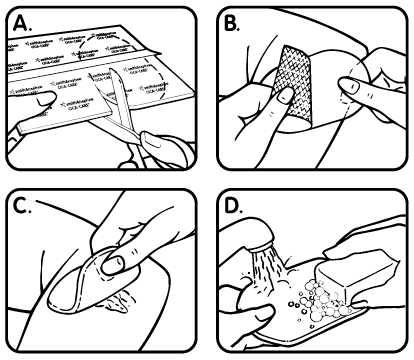













Effective in preventing1-2, softening, flattening and fading, red and raised scars - both old and new.3-6

| Size | Dressings per pack |
| 6cm x 12cm | 1 silicone gel sheet |
| 3cm x 12cm | 1 silicone gel sheet |
| 12cm x 15cm | 1 silicone gel sheet |

1. Smith+Nephew 2000.A Controlled Evaluation of CICA-CARE, Applied Following Suturing, in Preventing the Development of Hypertrophic Scars and Keloids Following Excision or Biopsy of Skin Lesions. Internal Report. STR/ST212/CT9604.
2. Gold MH, Foster TD, Adair MA, Burlison K, Lewis T. Prevention of Hypertrophic Scars and Keloids by the Prophylactic Use of Topical Silicone Gel Sheets Following a Surgical Procedure in an Office Setting. Dermatol Surg. 2001;27(7):641-644.
3. Momeni M, Hafezi F, Rahbar H, Karimi H. Effects of silicone gel on burn scars. Burns. 2009;35(1):70-74.
4. Smith+Nephew 2000.An Investigation of the Use of Cica-Care in the Treatment of Hypertrophic and Keloid Scars: A Clinical, Histological and Immunohistochemical Study. Internal Report. STR/ST214/CT9606.
5. Carney SA, Cason CG, Gowar JP, et al. Cica-Care gel sheeting in the management of hypertrophic scarring. Burns. 1994;20(2):163-167.
6. Al-Mandeel MS, Bang RL, Ebrahim MK. Re-appraisal of Cica-Care (Silicone gel sheet) in the treatment of hypertrophic and keloid scars. Saudi Med J. 1998;19(6):741745
7. Donald L. Comparison of 2 Types of Silicone Gel Sheets. Australian/New Zealand Burns Association(ANZBA). 1995;14:10-11.
8. Quinn KJ. Silicone gel in scar treatment. Burns. 1987;13:S33-S40.
9. Li-Tsang CWP, Lau JCM, Choi Jenny, Chan CCC, Jianan L. A prospective randomized clinical trial to investigate the effect of silicone gel sheeting (Cica-Care) on posttraumatic hypertrophic scar among the Chinese population. Burns. 2006;32(6):678683.
10. Derbyshire E. Innovations in skin camouflaging techniques: Where are we scientifically? Int J Cosmet Sci. 2019;41(6):526-533.
11. Ngaage M, And Agius M. The Psychology of Scars: A Mini-Review. Psychiatria Danubina. 2018;30(Suppl 7):633-638.
12. Smith+Nephew 2018.User verification testing of usability related Design Inputs for Cicacare Silicone gel sheet. Internal Report. U/040/R3.
13. Smith+Nephew 2018.Simulated Wash study to determine if CICA-CARE has the ability to withstand being wetted. Internal Report. U/040/R4.
14. Nikkonen MM, Pitkanen JM, Al-Qattan MM. Problems associated with the use of silicone gel sheeting for hypertrophic scars in the hot climate of Saudi Arabia. Burns. 2001;27(5):498-501.